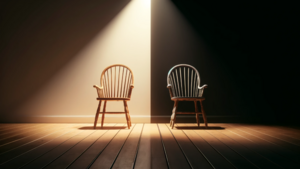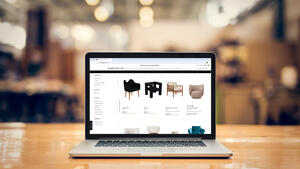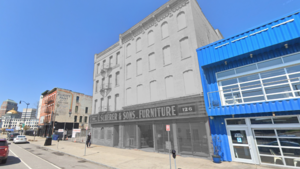An American walks into Bar Basso—and a thousand other Americans sit down next to him.
It’s not a joke (not a funny one, anyhow): It’s just business as usual in Milan during the city’s annual Design Week, when the sprawling Salone del Mobile fair comes to town and brings some half a million visitors with it. Winging in from all around the world, many will find their way to the famous Basso at some point—but even more will head to the center of the action, the gigantic Fiera Milano complex in suburban Rho. And while Italians still make up the majority of those perusing the booths of the 2,000 exhibitors there, at least one foreign country has had a growing presence in recent years.
“We’ve had a lot more interest from the U.S.,” says Maria Porro, director of the fair since 2021. “It’s a growing market, and American companies see a lot of potential here.” For years, both pre- and post-pandemic, the number of U.S. commercial attendees at Salone—buyers, designers, contract professionals of all shapes and sizes—never exceeded 4,000; suddenly, in 2023, this contingent shot above that figure by a solid 50 percent, remaining at a similar level this year, with around 6,000 Americans reportedly making the trek to the fairgrounds. That now makes the U.S. delegation the sixth-largest foreign group at the fair, a substantial leap from its 11th-place slot five years ago.
What’s behind the abrupt increase? A bit of post-Covid wanderlust is probably at play. So are macroeconomics. A trip to Salone is undeniably a splurge—hotels are known to mark up rooms 500 percent during the fair—but a better-than-average exchange rate for the U.S. dollar in recent years means that a week of dining out in Milan might end up costing less than it does in inflation-era New York.
The American invasion might also be a byproduct of an ever-shorter trend cycle, and a recognition that technology—social media in particular—makes the design industry more global with each passing year. “For us, coming to Salone is about being on top of trends and staying one step ahead of what everyone else is seeing in the States a few months later,” says interior designer Olga Medina of Miami-based firm CM Design Studio. “During Covid, everyone was behind a computer screen and sourcing from all over the world because people had more time—it wasn’t just the usual showroom visits; you’d be willing to take a Zoom from someone across the world. That interconnectedness catalyzed Salone to become even more influential.”
Joy Moyler, a New York–based designer and Salone veteran, concurs. “You never used to see that many Americans at the fair,” she says. “But there seems to be a larger interest from design editors in what Europe is doing these days. And with Instagram, there’s a whole lot of FOMO out there. Designers who historically wouldn’t attend are seeing the great products and parties and they want to be part of that environment.”
For others, Milan’s appeal has always been there. Interior designer Rydhima Brar, making her first voyage to Salone after four years at the helm of her Los Angeles–based practice, R/terior Studio, made the decision sound simple. “This is the world’s most renowned fair,” she said, sitting in a cafe inside Salone’s bathroom-furniture pavilion. “It’s always been on my wish list. I started with Las Vegas Market, then I went to High Point Market. But I decided it’s time to go international.”
The sudden rise in American fairgoers is somewhat ironic, given the overall decrease in booths inside the venue’s big metal sheds. This year, for the first time, only the main floor of the Salone facility contained furniture, as more and more legacy brands—including some North American ones—have decided to forgo the hassle and expense of showing in Rho in favor of mounting activations in Milan proper. This includes longtime Pennsylvanian staple Emeco, which launched the latest version of its aluminum chairs at the city’s Triennale museum, and the Canadian lighting brand Bocci, which opened a dedicated space in town last year instead of participating in the fair’s Euroluce exhibition. All in, only six U.S. brands were on-site at Salone del Mobile 2024.

For the ones that remain, there has been a redoubled effort to bring the kind of can’t-miss debuts that lure visitors out to Fiera Milano. A staple of the fair for 10 years, and a presence in Milan for decades, Knoll operates as the U.S. furniture industry’s de facto standard-bearer at Design Week; for this year’s installation, the company’s head of design, Jonathan Olivares, took a bold approach, debuting a sofa prototype by Canadian designer Willo Perron that defies almost every convention of what a Knoll sofa should be.
“We’ve always been missing something that’s super-comfortable, crash-out, Netflix-and-chill,” says Olivares. Soft, cushy and remarkably casual, the Perron Pillo sofa suggests a striking new direction for the storied brand, and a clear signal for Knoll’s audience back home that Milan is a place where new American design can thrive. “We see it as our job to show the flag here.”
And while big brands may be fewer in number in Rho, some younger American furniture designers are facing down considerable odds to exhibit, pulled in by the same centrifugal force as their compatriots. “This is our second time; the first Salone after the pandemic, we were here,” says Armando Mora Medina. Alongside his wife, Viviane Hernández, the Mexican-born designer is the co-founder of Brooklyn-based Design VA, a startup furniture operation with fabrication facilities in Guadalajara. The couple braved travel restrictions, contagion, and a last-minute, two-month postponement of the 2022 fair to participate in its new-designer showcase, SaloneSatellite. When they finally got to go, they found the place comparatively empty, with attendance that year nearly a third below pre-Covid levels.

Yet their experience was ultimately a positive one, and they returned this month to show off their ingenious bucketlike seating and glittering metal lighting. “We find this such a great way of growing our network,” says Hernández. “It helps us be bigger, to have bolder ideas.” The cost of the visit, including fabrication and shipping: about $35,000, Medina estimates. Larger brands—many of which declined to share their budgets—are known to spend far more. Showing in Milan is not a budget proposition, but it’s a price many are willing to pay.
“There’s just nothing like Milan to engage in a broad conversation on design and get your ideas to an audience,” says David Galullo, CEO and chief creative officer at San Francisco–based experiential design, interiors and brand strategy firm Rapt Studio. The designer has something of a bird’s-eye view of the goings-on in Milan: A longtime Salone attendee, he has also been an exhibitor of sorts, setting up an installation outside the main fair in 2019 and then another this year. Taking place in a large downtown storefront, Galullo’s current show, “Design Is Language; Speak for Yourself,” is not a commercial undertaking, strictly speaking. Consisting of three spaces, progressing from a cold and lifeless anteroom to a warm, apartmentlike interior at the rear—filled primarily with midcentury furniture acquired around Italy—it’s a museum-style polemic about the hazards and homogeneity of AI-driven design, an argument in favor of a more personal approach to the residential environment. “We want people to take design back, to give it narrative, meaning,” he explains.
But why come to Milan to do it—indeed, why come to Design Week at all, especially as a buyer? “It’s not exactly like we have to,” Galullo points out. “Five minutes after the fair closes, we’ve got salespeople knocking on our door with all the things that debuted.” A regular at other fairs stateside, he might have gone elsewhere this April: to High Point Market, for example, which overlapped with this year’s Salone.
But a show like “Design Is Language” is not the norm in North Carolina. Fuorisalone offers a semiorganized medley of programming that unfolds in every nook and cranny of the city, producing a kind of synergistic energy with Salone that doubtless helps bolster attendance for both. Only blocks away from the Rapt storefront, Google was staging an exhibition of its own—a 21-room light and sound installation. On the other side of town, Lexus was hosting its annual automotive-themed activation that explored the future of mobility and equated luxury with carbon neutrality. Fashion boutiques galore were showing their interior-themed wares and architect collaborations, with openings and vernissages nearly every night. As it happens, many of these brands (including Google and the shoe company Vans) are important clients for Rapt.

For Americans looking to expand their reach and make their mark, Milan Design Week remains the best game going—and while some might come to town but skip the main fair, many more will still see the trip to Rho as part of the package, a chance to discover what’s new and forge connections with the people behind it.
After only a day or two of cruising through the facility, Brar was already prepared to call the excursion a success. “I’ve had so many people saying, ‘Hey, can we email you our catalog? Can you come tour our factory?’” said the L.A. designer. “It totally validates the trip.”





























